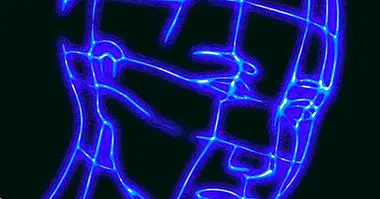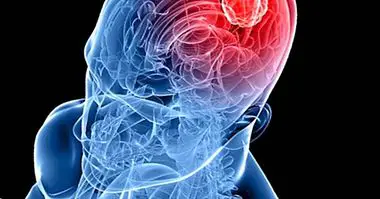What is an obsession? Causes, symptoms and treatment
Most of the people have passed moments in which, due to times of anxiety, stress or difficult situations, we have experienced a series of recurrent and uncontrollable ideas or thoughts that have generated high levels of anguish.
However, although these experiences are generally normal, we run the risk of these thoughts becoming obsessions . So that this does not happen, we will be very useful to know what these obsessions consist of, as well as their typologies and the resources we have at our disposal to combat them.
- Related article: "Rumination: the annoying vicious circle of thought"
What is an obsession?
Obsessions, or obsessive thoughts, are dynamics of thought in which the mind of the person clings to a fixed idea . Usually, these ideas are associated with some event, event or situation that supposes a concern for this that generates feelings of fear or anguish.
For a thought to be considered obsessive, it must fulfill a series of characteristics. The first is that these ideas must be repetitive and recurrent ; that is, they constantly appear in the mind of the person.
In addition, they must also arise involuntarily and be uncontrollable; This means that, no matter how hard the person tries not to think about them or eliminate them from their head, these ideas will come back to mind, perhaps even more strongly.
The most common causes that give rise to these obsessions or obsessive thoughts are the states of anxiety and psychological stress . In both cases the person experiences a series of worries or recurring fears that, in addition, tend to worsen the symptoms of anxiety.
Therefore, the person is involved in a vicious circle in which he suffers an anxiety that causes a series of obsessive thoughts, which in turn contribute to feed more symptoms of such anxiety.
The ways in which these obsessive thoughts are externalized are many and very diverse, and in most cases they will be influenced by the personality traits of the subject , as well as the context that surrounds it. Obsessive behaviors related to order, cleanliness or physical appearance, are the reflection of these ideas that obfuscate the mind of the person.
- Maybe you're interested: "The 7 types of anxiety (causes and symptoms)"
What differentiates a concern from an obsession?
Although it is true, that a worry can become an obsession, and in turn this can acquire a degree of chronicity that makes it pathological , there are a series of differences that allow us to distinguish between a concern and an obsessive idea.
Unlike the concerns of more normative category, obsessive thoughts have a much higher degree of intensity, frequency and duration, so they are also likely to cause much more discomfort.
Also, in the case of obsessions, the subject has almost no control over them. That is to say, they show a much greater resistance to the attempts of the person to eliminate them from their head .
Finally, according to a study by Paul Salkovskis, professor of clinical psychology and applied sciences at the University of Bath, revealed that 90% of mentally healthy people experienced a series of intrusive ideas related to concerns that caused a high degree of distress and discomfort, but that did not reach the category of obsessions.
When can they be considered pathological?
As we have seen previously, a large number of people have to experience a series of obsessive thoughts which do not have to be linked to any type of psychological pathology. However, there is a risk that these obsessions may become chronic obsessive thoughts, which may reach become an obsessive disorder and interfere remarkably in the day to day of the person.
Regulatory category obsessions or concerns tend to disappear over time, or once the problem has been solved. However, these thoughts can be very distressing and stressful.
When these thoughts become severe obsessions and are accompanied by compulsive acts aimed at reducing the discomfort it is very possible that the person suffers the well-known obsessive-compulsive disorder (OCD). In this case the obsessions have to be classified as pathological, since they are part of a much broader symptomatology.
Also, although it is not a general rule, the thoughts of this type of psychological alteration do not have to be subject to reason . That is, the ideas or concerns that flood the patient's mind may be incoherent or have no rational basis.
For example, the person may think uncontrollably and constantly that if the light is left on, something bad may happen to him when he leaves the house, therefore he performs compulsive and constant checks. Here it is shown how thoughts are not necessarily logical, since they unite two facts that in reality have nothing to do with it.
Finally, although the person may come to accept that their ideas do not start from any logical principle, it is not able to eliminate these obsessions at all.
Types of obsessions
As for the content of obsessive thoughts, these can be as varied as people exist in the world. However, there are a series of relatively recurrent obsessions both within the population that suffers from OCD, and in those people who, due to anxiety or stress suffered, experience this type of uncontrollable ideas.
Some types of obsessive ideas include:
- Obsession by order and organization .
- Obsessive fears in relation to the home. How to close the whole house, leave it light or open gas, etc.
- Irrational and obsessive ideas about cleanliness and diseases .
- Obsessive fear to run some danger of physical type.
- Obsessive thoughts of a sexual nature .
How to manage these thoughts?
In cases in which the obsessions are part of a diagnosis of obsessive-compulsive disorder, it will be necessary for the person to visit a mental health professional to initiate a therapy appropriate to their condition.
However, if these thoughts are only due to a particularly complicated stage of life, there are some techniques or steps that the person can carry out in order to diminish or eliminate these thoughts. These techniques include:
- Keep the mind and body active through physical exercise.
- Do not try to stop or control your thoughts , but let these temporarily flow until their intensity decreases.
- Know the origin of these and try to solve the problem.
- Reflect these thoughts in writing.
- Carry out relaxation techniques.
- If nothing works go to a professional in psychology .



















